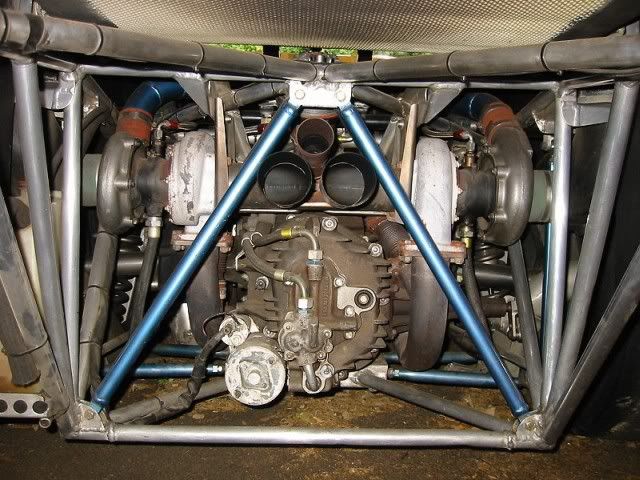Take a Trip in the "Way Back" Machine
This week I thought we would take a trip back in time to what many refer to as the "glory days" of motorsport - the late 1960s to early 1970s - and look at one of the iconic race series in North America: the Can Am (short for Canadian-American).

Above, The McLaren M6A, (with Bruce at the wheel) powered by the venerable small-block Chevy V8, developing over 500 HP with Lucas mechanically timed fuel injection, was the dominant car in the Can Am series in 1967 (the M6B was introduced in 1968). In 1968 McLaren also introduced the M8 (shown below) which was powered by an all-aluminum, big-block Chevy (now fitted with Hilborn mechanical fuel injection) developing some 800 HP. One major difference besides the engine upgrade and bodywork design, was that the engine was now a "stressed member" meaning that, instead of being bolted "into" the chassis, the engine became an integral part of the chassis (increasing rigidity), an engineering design feature that is almost standard for all race cars now.


Let's take a lap in an M6B at Laguna Seca, shall we?

Here's an M6B at Sears Point (now known as Infineon) Raceway. Note the throttle linkage working as the driver gets on and off the gas.

Now, sit back and enjoy some historic footage filmed at the 1967 Can Am event at Road America in Elkart Lake, Wisconsin.

McLaren, who created these dominant cars that became synonymous with Can Am, died tragically in 1970 in an accident while testing at Goodwood in the UK. His name and trademark, however, continued on as you may well know in not only F1 but in various tuner cars that bear his mark.

Above is the Porsche 917/30 Can Am racer driven by Mark Donohue. Below is a photo of the gearbox and rear undercarriage. Notice the two medium-large turbochargers on either side of the engine.


Below is a video with historical background on the 917/30 containing some race footage and a portion of an interview with team owner Roger Penske and his championship-winning driver, the late Mark Donohue whose son, David, now contests a Brumos Porsche prototype in the Grand Am road-racing series, a modern "revival" of the Can Am.

This video shows a 917/30 at start-up and driving out of the pits.

I hope you have enjoyed this trip in the Way Back Machine. There's lots more to come, so check back often.
Can-Am started out as a race series for Group 7 sports racers with two races in Canada (Can) and four races in the United States of America (Am). The series was initially sponsored by Johnson Wax. The Series was governed by rules called out under the FIA Group 7 category with unrestricted engine capacity and few other technical restrictions.The "Bruce and Denny Show" refers to the domination of the series by two New Zealanders, Bruce McLaren and Dennis "Denny" Hulme; Chris Amon, also a Kiwi, factored prominantly in the series.
The Group 7 category was essentially a formule libre for sports cars; the regulations were minimal and permitted unlimited engine sizes (and allowed turbocharging and supercharging), virtually unrestricted aerodynamics, and were as close as any major international racing series ever got to anything goes. As long as the car had two seats and bodywork enclosing the wheels, and met basic safety standards, it was legal. Group 7 had arisen as a category for non-homologated sports car 'specials' in Europe and for a while in the 1960s Group 7 racing was popular in the United Kingdom as well as a class in hillclimb racing in Europe. Group 7 cars were designed more for short-distance sprints than for endurance racing. Some Group 7 cars were also built in Japan by Nissan and Toyota, but these did not compete outside their homeland (though some of the Can-Am competitors went over to race against them occasionally).
{snip}
On-track, the series was initially dominated by Lola, followed by a period in which it became known as the 'Bruce and Denny Show', the works McLaren team dominating until the Porsche 917 was perfected and became almost unbeatable. After Porsche's withdrawal, Shadow dominated the last season before Can-Am faded away to be replaced by Formula 5000. Racing was rarely close - one marque was usually dominant - but the noise and spectacle of the cars made the series highly popular.

Above, The McLaren M6A, (with Bruce at the wheel) powered by the venerable small-block Chevy V8, developing over 500 HP with Lucas mechanically timed fuel injection, was the dominant car in the Can Am series in 1967 (the M6B was introduced in 1968). In 1968 McLaren also introduced the M8 (shown below) which was powered by an all-aluminum, big-block Chevy (now fitted with Hilborn mechanical fuel injection) developing some 800 HP. One major difference besides the engine upgrade and bodywork design, was that the engine was now a "stressed member" meaning that, instead of being bolted "into" the chassis, the engine became an integral part of the chassis (increasing rigidity), an engineering design feature that is almost standard for all race cars now.


Let's take a lap in an M6B at Laguna Seca, shall we?

Here's an M6B at Sears Point (now known as Infineon) Raceway. Note the throttle linkage working as the driver gets on and off the gas.

Now, sit back and enjoy some historic footage filmed at the 1967 Can Am event at Road America in Elkart Lake, Wisconsin.

McLaren, who created these dominant cars that became synonymous with Can Am, died tragically in 1970 in an accident while testing at Goodwood in the UK. His name and trademark, however, continued on as you may well know in not only F1 but in various tuner cars that bear his mark.
On 2 June 1970, Bruce McLaren was killed in a crash at Goodwood while testing the new M8D Can-Am car. While travelling at 170 mph (270 km/h), a fastener for the rear bodywork failed and the entire rear piece detached from the car. The car spun into a concrete marshal post and McLaren was killed instantly. Twelve days after Bruce McLaren's death Dan Gurney won the opening Can-Am race of 1970 at Mosport for McLaren. The McLaren M8D won nine of the ten races in 1970 and Hulme won the championship.As mentioned above, the McLaren domination began to come to an end in 1971 when Porsche entered the scene with their 917/10 and the further upgraded 917/30. The 917/30, combined with the energy "crisis" of the mid-1970s, effectively killed the Can Am series even though some teams tried turbos on their big-block Chevy McLarens; the power was there, but reliability was not.
At the end of the 1971 season, the coupe bodied Porsche 917 was no longer eligible to race in the world championship, which saw the German manufacturer's focus shift to the Group 7 class. In open form the 917 had been campaigned in this virtually no limits class since 1969, but with little factory support. Two championships were open for the Group 7 cars; the European Interserie and more importantly the North American Can-Am Challenge. Big engines, low weight and a host of different looking vehicles had made Can-Am one of America's premier classes, attracting many spectators.With its upwards of 1100-1200 HP on tap, the 917/30 is considerd by many to be the world's first real "supercar". It could accelerate from 0-60mph in 2.2 seconds; 0-100mph in under 4 seconds; and 0-200mph in under 12 seconds; and achieve top speeds of upwards of 250mph.
Porsche was represented in Can-Am for a number of years by privateers who race 908s or decapitated 917s, until a purpose built Group 7 version of the 917 made its debut in 1971. Dubbed the 917/10, it was technically similar to the coupe 917, but featured a number of lighter components constructed from the latest exotic materials. A larger fuel tank was also fitted to enable the car to complete the 200 mile races without having to refuel. Completely new was the spyder bodywork, which was an adaptation of the contemporary Can-Am design.
A few races into the 1971 season, the Porsche 917/10 made its debut in the McLaren dominated series. It was immediately obvious that the 5 litre flat 12 was not powerful to take on the might of the all-alloy Chevrolet V8s, but nonetheless valuable points were scored in the car's first season. Back in Germany two options to close the gap with the 800 bhp V8s were considered; a 16 cylinder version of the 917 or fitting Turbochargers to the existing engine. The second option was by far not as easy as it sounds today, but it was expected to offer the best performance so it was fully explored.
In the preceding fifty years racing cars were either Naturally Aspirated or equipped with a Supercharger driven by the crank; exhaust driven Turbochargers was uncharted territory. Throttle lag was the biggest problem to overcome with Turbos. In order to operate ideally the turbines in the Turbo had to run at a specific speed, but that requires a minimum amount of engine revolutions. When the engine was running under that number, there was considerably less power, and when the Turbos did kick in it was not a gentle affair. Drivers of the Turbocharged 917s needed to have a very delicate right foot and stellar reflexes to cope with the sudden power increases.
In five litre form, the Turbocharged flat 12 was good for around 950 bhp; not for the faint of heart. In Mark Donohue and George Follmer Porsche found two drivers brave enough to take on the competition in their 917/10K. Donohue proved to be the faster of the two, but an accident early in the season left him out for most of the remaining races. This paved the way for George Follmer to finally challenge and beat the McLarens and secure the championship. In Europe the 917/10Ks were campaigned in 4.5 litre form, but it was still enough to clinch a one-two in the championship.
Although the McLarens were convincingly beaten in 1972, Porsche continued the development and constructed the most powerful racing car ever. Available only for Team Penske's driver Mark Donohue, the 917/30 was bigger in every aspect compared to the 1972 racer. The engine's displacement was increased to 5.4 litre, which saw the performance rise to at least 1100 bhp in race trim. A new longer and aerodynamically efficient body was fitted, which increased the top speed considerably. In the 1973 season there was no stopping the 'Turbo Panzer', and Mark Donohue won the championship.
As a side effect of the Porsche dominance, Can-Am was quickly losing teams and spectators and halfway through the 1974 season the challenge was cancelled. Porsche had also withdrawn at the end of the 1973, but the 917/30 was given one final outing in 1975. Specifically prepared for a high speed run, Donohue lapped the Talladega race track at an average of 221 mph in the 917/30, setting a new world record. A fitting finale for the Porsche 917's magnificent career. Unfortunately it was also the finale of Donohue's career, who fatally crashed ten days later during Formula 1 qualifying in Austria.

Above is the Porsche 917/30 Can Am racer driven by Mark Donohue. Below is a photo of the gearbox and rear undercarriage. Notice the two medium-large turbochargers on either side of the engine.


Below is a video with historical background on the 917/30 containing some race footage and a portion of an interview with team owner Roger Penske and his championship-winning driver, the late Mark Donohue whose son, David, now contests a Brumos Porsche prototype in the Grand Am road-racing series, a modern "revival" of the Can Am.

This video shows a 917/30 at start-up and driving out of the pits.

I hope you have enjoyed this trip in the Way Back Machine. There's lots more to come, so check back often.
Labels: Auto Erotica, Racing, The Way Back Machine









2 Comments:
Way Back Machine? Dear Joe, as I face the big seven-oh tomorrow, you have managed to make me feel even older.
The sixties and seventies seem like just yesterday to me.
LOL, Nan! I was just a small kid then, and the older I get it seems just like yesterday for me as well. I really enjoy doing this kind of thing; it takes my mind off all the crap going on in the world today. And even though I'm fairly knowledgable in this area, when I do background research, I still find that I learn something.
Post a Comment
<< Home